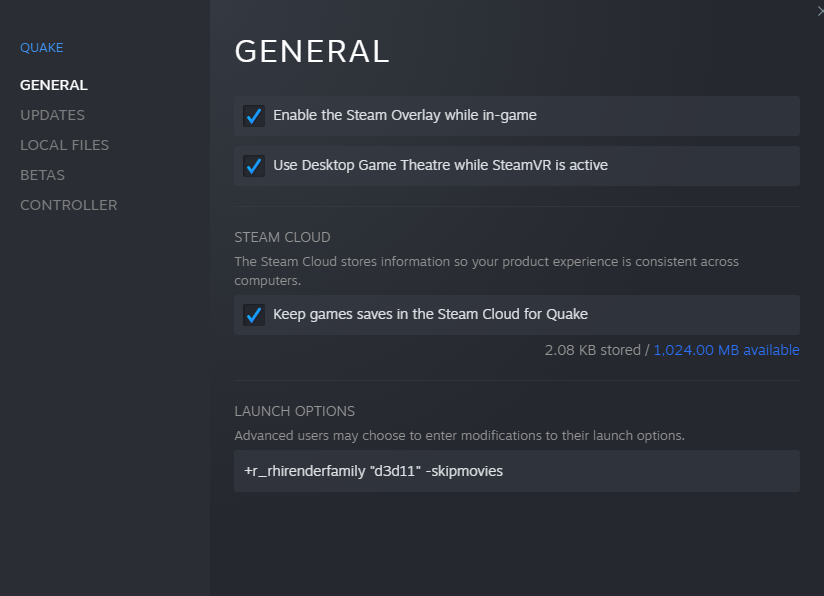Quake Fix Input Lag, Stuttering & Mouse Behaviour
Welcome to our Quake Fix Input Lag, Stuttering & Mouse Behaviour guide. Here’s a quick fix for everyone experiencing issues with the 2021 remaster of the game made by Nightdive Studios.
This Game Uses Vulkan as Primary API..
..but fortunately, you can switch to Direct3D 11!
Right-click your game in your library and enter the following into the launch options line:
+r_rhirenderfamily “d3d11”
With the quotes! It should look like this:

(Note: -skipmovies is absolutely optional, but you should totally do it because it skips the annoying splash screens)
Now start the game back up and enjoy perfect gameplay like you were used to in OG Quake!
If This Doesn’t Work
..or you simply wanted to test, do the following:
Delete the line out of the launch options and launch the game. Once you can access the console using the tidle key, enter
+r_rhirenderfamily “vulkan”
And afterwards restart.
(Don’t actually restart your computer, just enter the word “restart” into console.)
You can also enter the line in the launch options if you want.
Gameplay
In Quake’s single-player mode, players explore levels, facing beasts and discovering secret areas before reaching an exit. Switches or secrets open doors, and reaching the exit takes the gamer to the next level. Prior to accessing an episode, there is a set of three paths with simple, medium, and hard skill levels. The fourth skill level, “Nightmare”, was “so bad that it was concealed, so people won’t roam in by mishap”; the gamer should drop through water prior to the episode four entrance and enter into a secret passage to access it.
Quake’s single-player project is arranged into four private episodes with 7 to eight levels in each (including one secret level per episode, one of which is a “low gravity” level that challenges the gamer’s abilities in a different way). If the gamer’s character passes away, they must restart at the start of that level. The video game might be saved at any time in the PC variations and between levels in the console versions. Upon finishing an episode, the gamer is returned to the center “START” level, where another episode can be picked.
Each episode begins the gamer from scratch, without any formerly collected products. Episode one (which formed the shareware or downloadable demonstration variation of Quake) has the most standard ideology of a boss in the last level. The ultimate objective at the end of each episode is to recover a magic rune. After all of the runes are gathered, the floor of the center level opens to reveal an entrance to the “END” level which includes a last puzzle.
Multiplayer
In multiplayer mode, gamers on numerous computers connect to a server (which may be a devoted machine or on among the player’s computers), where they can either play the single-player campaign together in co-op (cooperative) mode, or bet each other in multiplayer. When players pass away in multiplayer mode, they can immediately respawn, but will lose any products that were collected. Likewise, products that have actually been picked up formerly respawn after some time, and might be gotten once again.
The most popular multiplayer modes are all types of deathmatch. Deathmatch modes generally include either free-for-all (no company or teams involved), individually duels, or arranged teamplay with 2 or more gamers per group (or clan). Players often implement mods throughout teamplay. Monsters are not usually present in teamplay, as they serve no purpose other than to obstruct and reveal the positions of the gamers.
The gameplay in Quake was thought about special for its time because of the various methods the player can navigate through the video game. Bunny hopping or strafe jumping permit faster motion, while rocket jumping enables the gamer to reach otherwise-inaccessible locations at the cost of some self-damage. The player can start and stop moving all of a sudden, jump unnaturally high, and alter direction while moving through the air. A number of these non-realistic habits contribute to Quake’s appeal.
..I fail to see how switching the renderer to a high-level graphics API (D3D11) over a low-level graphics API (Vulkan) will help to reduce latency…